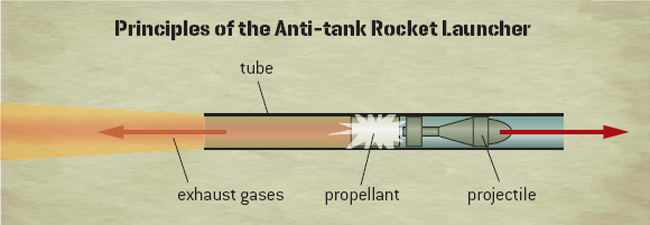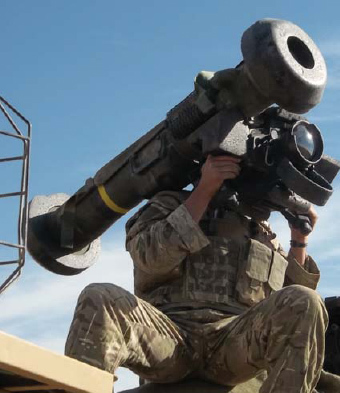The Germans developed the first recoilless rifle with the Panzerfaust 150. This was a primitive RPG and the Russians copied it to produce the RPG2 which became the RPG7.
The recoilless rifle principle was also employed by the USA in the ‘Bazooka’ during World War II. This was a pipe of some 3.5in diameter, operated from the shoulder, which launched a projectile comprising an armour-piercing charge. When initiated by a trigger, the charge attached to the rear of the projectile pushed the projectile forwards but, because the gases were allowed to escape to the rear freely, there was no recoil, just a strong rearward blast. This enabled a single soldier to fire the relatively heavy projectile a long way horizontally without requiring a mounting to withstand the recoil.
The bazooka was refined over the years by Western forces, passing through several incarnations, which included the 84mm Carl Gustav, but retained the same operating principle. In recent years hand-held rocket launchers have become smaller and lighter while still packing a fair punch.
The USA has opted for very light disposable anti-tank rocket launchers while the Russians, and therefore most insurgents, have stuck with the RPG group. The latest model, the RPG29, has knocked out Merkava, Challenger and Abrams main battle tanks in desert warfare.
Operation: How does it work?
There are two clever principles which combine to make a modern hand-held rocket launcher work. The first is that the heavy projectile is driven forward by the detonation of a propellant charge which is also allowed to escape out of the rear of the launching tube. Those with the physics will see that this stops any recoil. Those without physics will have to try firing one.

The other clever idea is the shaped charge. All rocket launchers employ the shaped charge principle in at least some of their projectiles. This enables a relatively small charge to generate an immense directional blast sufficient to cut through armoured steel of great thickness, often over 10in. I haven’t supplied a diagram detailing the operation of a shaped charge on the grounds that its principles may be used by terrorists and insurgents. There are other types of charge which have been developed to defeat composite armour but we don’t need to share that information here either.
Skill: How do you use the weapon to maximum efficiency?
Using an RPG, or any other model rocket launcher, is not rocket science (sorry). Point and shoot but remember that you have a slow moving projectile compared with a bullet so when aiming at a moving target such as vehicles or aircraft try to get yourself in line with its direction of travel – either straight ahead or to the rear of the target so it is not moving across your field of view. Again, for obvious reasons I am not about to point out the weak points on our kit but be sure to familiarize yourself with these once on the ground.
Types of grenade launchers
The Russians came up with what is probably the best light anti-tank weapon ever made. The famous RPG7 or Rocket Propelled Grenade Mk7. This employs the same principle as the Bazooka, Carl Gustav and LAW66 but the tube is narrow and the fatter projectile sticks out of the front of the tube while the candle-like propellant charge screws to the back of the projectile and then is slid inside the tube as the weapon is prepared for use.
Like all Russian weapons the RPG works every time even when dirty. It has a range of some 1,100m and then the charge self destructs – so if it lands on soft ground next to you it will still go off. It is very accurate and has a similar penetrative ability to the Western weapons – some 10–12in of armour.

The LAW66: The USA has produced a miniature, lightweight disposable weapon called the LAW66 presumably from it having a 66mm calibre and being a Light Anti-Tank Weapon. This clever little toy uses the same principles as the RPG but is made in high-tech US factories so it weighs only a few pounds and telescopes up from around 18in to a working length of a couple of feet.
At close range it is effective against armour up to nearly a foot thick. I have myself tested them against sections of the HMS Ark Royal aircraft carrier armoured deck (after it had been scrapped you’ll be pleased to know) up-ended on a firing range. The projectile cut a clean 66mm hole through 10in of armoured steel with only a few drips of molten steel to spoil a perfectly clean hole. I was quite amazed at the power of such a little thing. On the down side, the 66 can be inaccurate and the projectile has a tendency to bounce off armour if it hits at a shallow angle.
The Wombat: The Wombat was effectively a huge Recoilless Rifle with a 120mm calibre tube which was issued to the British Army some years ago. Several weapons of this type were in use around the world as medium-weight vehicle-portable anti-tank weapons. Very often you would see a Wombat-type weapon towed behind or mounted on the back of a Land Rover or other vehicle.
FGM-148 Javelin Anti-Tank Guided Missile Launcher: Rocket launchers have now been replaced by man portable missiles in NATO armies as these pack a bigger punch over a greater range and can often be guided onto the target by wire. This weapon is an anti-tank missile made by the US and is not to be confused with the Javelin surface-to-air missile built by the British. To maintain the confusion, the US and the British both use the FGM-148 Javelin as an anti-tank and anti-building weapon in Afghanistan and elsewhere. I shall refer to the FGM-148 as the ‘Javelin’ for convenience in this section.
Though designed to attack armour, the main use you are likely to make of this weapon is to destroy buildings or bunkers with enemy in them or knock down substantial walls. At around $32,000 (£20,000) a shot you don’t want to waste them – unless, of course, you are not paying. In any event the chances of you missing at anything up to 2,500 yards are minimal as you have excellent infrared sights and are usually aiming at something the size of a house.

FGM-148 Javelin Anti-Tank Guided Missile Launcher Afghanistan 2010. (Photo courtesy Tom Blakey)
The Javelin has two modes of fire settings which cause the missile to travel either high or low to the target. These are Top Attack and Direct Attack. In Top Attack the missile gains height to around 500 feet and then drops onto the target from above on the premise that the armour on a tank is thinner on top. In Direct Attack mode the missile only climbs to around 200 feet and therefore travels on a flatter trajectory to the target. You would generally select Direct Attack mode to destroy buildings etc.
The Javelin is a ‘fire and forget’ guided weapon so the way it works is you line up on the target, select the mode of fire and let it go. The missile then guides itself onto the target and gives it a hefty thump with an 18.5lb explosive charge. When you press the trigger one propellant charge drives the missile out of the tube and there is some back blast. When the missile has travelled a little way the main rocket motor ignites and propels the missile the remainder of the way to the target.
The warhead is very clever and consists of two shaped charges which work together to defeat all the latest types of spaced, ceramic and explosive armour. During the invasion of Iraq these missiles proved devastating against the Russian T72s fielded by the opposition.
Summary: What are the important things to remember about grenade launchers?
If you forget everything else I tell you, remember there is one hell of a back-blast from all types of rocket launcher. The choice is between the accuracy of the RPG7 and the light weight of the 66. On balance the RPG isn’t so heavy and the tube – which I think is fibreglass or tin depending on the model – can be carried separate from the projectiles and propellant. I think the RPG just gets the vote for accuracy but the 66 is certainly better to carry. So it depends on the job and the circumstances – like so much in life. By the time the rocket is fired at you it is too late to do anything about it so make sure your vehicles are fitted with an external grid of some kind to detonate rockets and keep a screen of infantry between aircraft and potential RPG7 launch points. Maintain constant vigilance on convoy duty and use infantry screens as explained elsewhere.